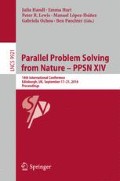Abstract
A novel method for regulation of gene expression for artificial cellular systems is introduced. It is based on an instructon-based representation which allows self-modification of genotype programs, as to be able to control the expression of different genes at different stages of development, e.g., environmental adaptation. Coding and non-coding genome analogies can be drawn in our cellular system, where coding genes are in the form of developmental actions while non-coding genes are represented as modifying instructions that can change other genes. This technique was tested successfully on the morphogenesis of cellular structures from a seed, self-replication of structures, growth and replication combined, as well as reuse of an evolved genotype for development or replication of different structures than initially targeted by evolution.
Access this chapter
Tax calculation will be finalised at checkout
Purchases are for personal use only
References
Alon, U.: An Introduction to Systems Biology: Design Principles of Biological Circuits. CRC Press, Boca Raton (2006)
Altenberg, L., et al.: The evolution of evolvability in genetic programming. In: Advances in Genetic Programming, pp. 47–74 (1994)
Bidlo, M., Škarvada, J.: Instruction-based development: from evolution to generic structures of digital circuits. Int. J. Knowl.-Based Intell. Eng. Syst. 12(3), 221–236 (2008)
Bidlo, M., Vasicek, Z.: Evolution of cellular automata using instruction-based approach. In: Congress on Evolutionary Computation, pp. 1–8. IEEE (2012)
Clune, J., Mouret, J.B., Lipson, H.: The evolutionary origins of modularity. Proc. Royal Soc. Lond. B: Biol. Sci. 280(1755), 20122863 (2013)
Glover, T.: An investigation into cellular automata: the self-modifying instruction-based approach. Master thesis (2015)
Harding, S.L., Miller, J.F., Banzhaf, W.: Self-modifying cartesian genetic programming. In: Miller, J.F. (ed.) Cartesian Genetic Programming, pp. 101–124. Springer, Heidelberg (2011)
Kampis, G.: Self-modifying Systems in Biology and Cognitive Science: A New Framework for Dynamics, Information and Complexity, vol. 6. Elsevier, Amsterdam (2013)
Kashtan, N., Alon, U.: Spontaneous evolution of modularity and network motifs. Proc. Nati. Acad. Sci. U. S. A. 102(39), 13773–13778 (2005)
Kitano, H.: Designing neural networks using genetic algorithms with graph generation system. Complex Syst. J. 4, 461–476 (1990)
Kitano, H.: Building complex systems using developmental process: an engineering approach. In: Sipper, M., Mange, D., Pérez-Uribe, A. (eds.) ICES 1998. LNCS, vol. 1478, pp. 218–229. Springer, Heidelberg (1998)
Kovitz, B.: Experiments with cascading design. In: Proceedings of the 13th European Conference on Artificial Life (ECAL 2015), Workshop EvoEvo (2015)
Kowaliw, T., Banzhaf, W.: Augmenting artificial development with local fitness. In: Congress on Evolutionary Computation, pp. 316–323. IEEE (2009)
Koza, J.R.: Genetic Programming: On the Programming of Computers by Means of Natural Selection, vol. 1. MIT press, Cambridge (1992)
Kumar, S., Bentley, P.J.: Biologically inspired evolutionary development. In: Tyrrell, A.M., Haddow, P.C., Torresen, J. (eds.) ICES 2003. LNCS, vol. 2606, pp. 57–68. Springer, Heidelberg (2003)
Martin, A.P.: Increasing genomic complexity by gene duplication and the origin of vertebrates. Am. Nat. 154(2), 111–128 (1999)
Miller, J.F., Thomson, P.: Cartesian genetic programming. In: Poli, R., Banzhaf, W., Langdon, W.B., Miller, J., Nordin, P., Fogarty, T.C. (eds.) EuroGP 2000. LNCS, vol. 1802, pp. 121–132. Springer, Heidelberg (2000)
Mitchell, M.: Complexity: A Guided Tour. Oxford University Press, Oxford (2009)
Nichele, S., Giskeødegård, A., Tufte, G.: Evolutionary growth of genome representations on artificial cellular organisms with indirect encodings. Artif. Life 22(1), 76–111 (2016)
Nichele, S., Tufte, G.: Trajectories and attractors as specification for the evolution of behaviour in cellular automata. In: 2010 IEEE Congress on Evolutionary Computation (CEC), pp. 1–8. IEEE (2010)
Nichele, S., Tufte, G.: Evolutionary growth of genomes for the development and replication of multicellular organisms with indirect encoding. In: 2014 IEEE International Conference on Evolvable Systems (ICES), pp. 141–148. IEEE (2014)
Sipper, M.: Evolution of Parallel Cellular Machines. Springer, Heidelberg (1997)
Stanley, K.O., Miikkulainen, R.: Achieving high-level functionality through complexification. In: Proceedings of the AAAI-2003 Spring Symposium on Computational Synthesis, pp. 226–232 (2003)
Stanley, K.O., Miikkulainen, R.: Competitive coevolution through evolutionary complexification. J. Artif. Intell. Res. (JAIR) 21, 63–100 (2004)
Taylor, J.S., Raes, J.: Duplication and divergence: the evolution of new genes and old ideas. Annu. Rev. Genet. 38, 615–643 (2004)
Trefzer, M.A., Kuyucu, T., Miller, J.F., Tyrrell, A.M.: On the advantages of variable length grns for the evolution of multicellular developmental systems. IEEE Trans. Evol. Comput. 17(1), 100–121 (2013)
Von Neumann, J., Burks, A.W., et al.: Theory of self-reproducing automata. IEEE Trans. Neural Netw. 5(1), 3–14 (1966)
Author information
Authors and Affiliations
Corresponding author
Editor information
Editors and Affiliations
Rights and permissions
Copyright information
© 2016 Springer International Publishing AG
About this paper
Cite this paper
Nichele, S., Glover, T.E., Tufte, G. (2016). Genotype Regulation by Self-modifying Instruction-Based Development on Cellular Automata. In: Handl, J., Hart, E., Lewis, P., López-Ibáñez, M., Ochoa, G., Paechter, B. (eds) Parallel Problem Solving from Nature – PPSN XIV. PPSN 2016. Lecture Notes in Computer Science(), vol 9921. Springer, Cham. https://doi.org/10.1007/978-3-319-45823-6_2
Download citation
DOI: https://doi.org/10.1007/978-3-319-45823-6_2
Published:
Publisher Name: Springer, Cham
Print ISBN: 978-3-319-45822-9
Online ISBN: 978-3-319-45823-6
eBook Packages: Computer ScienceComputer Science (R0)

